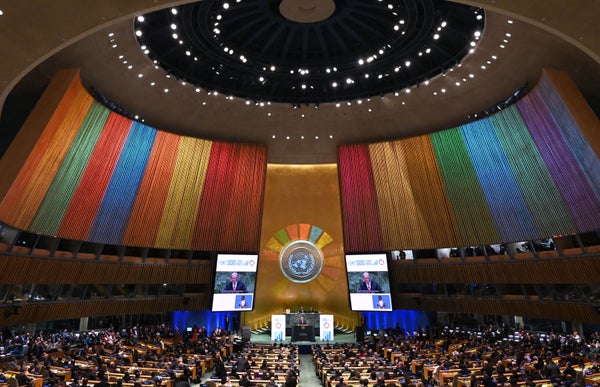World leaders this week vowed to redouble their efforts on an ambitious plan to end poverty and protect the environment, which is woefully behind schedule.
None of the United Nations' 17 Sustainable Development Goals (SDGs), outlined in 2015, will be met by the self-imposed 2030 deadline. Governments and leaders are better at making promises than at keeping them, scientists have told Nature. However, there are signs that the SDG agenda is having an impact, they say.
A 12-page “political declaration,” approved during the UN SDG Summit in New York on 18 and 19 September, declares that the goals remain the world’s “overarching roadmap” for the future. “We will act with urgency to realize its vision as a plan of action for people, planet, prosperity, peace and partnership, leaving no one behind,” the agreement states.
On supporting science journalism
If you're enjoying this article, consider supporting our award-winning journalism by subscribing. By purchasing a subscription you are helping to ensure the future of impactful stories about the discoveries and ideas shaping our world today.
“The SDGs need a global rescue plan,” UN secretary-general António Guterres declared at the opening of the summit. Guterres is proposing to increase funding for sustainable development by at least US$500 billion to help countries to achieve the goals, as well as other financial aid, including debt relief for the poorest nations so they can survive and thrive after economic shocks.
The political declaration arrives amid evidence and analysis suggesting that governments are falling well short of the goals.
There is hope for the SDGs yet
Researchers involved in the four-yearly Global Sustainable Development Report (GSDR) analysed 36 of the 169 detailed targets that accompany the overarching goals. Of these, the scientists found that the world is on track to achieve only two targets — those aimed at increasing access to the Internet and to mobile-phone networks.
Twelve targets showed little or no progress. In some cases, such as food security, vaccine coverage and greenhouse-gas emissions, trends are going in the wrong direction. The research suggests that without further action and resources, the world will be unlikely to achieve the goals even by 2050, two decades late.
Paula Caballero, the former Colombian diplomat who was instrumental in creating the SDGs’ framework, says that the world needs to take bold and transformational action now to accomplish the SDG agenda.
At the same time, she says that 2030 should not be seen as a final ‘take-it-or-leave-it’ deadline. “Let’s not think that 2030 is an end goal,” says Caballero, who is now responsible for the Latin American activities of The Nature Conservancy, a conservation organization based in the United States. “It’s a milestone.”
Sociologist Shirin Malekpour, one of the GSDR authors, agrees. “What needs to change is what we are doing, not the targets and the goals,” says Malekpour, who is at Monash University in Melbourne, Australia.
Malekpour sees some hope in the political declaration, which says that countries will not only continue to integrate the SDGs into national policies, but also “develop national plans for transformative and accelerated action.”
“If, outside of everything else, they just do this one thing, I think we will actually see huge progress,” she says.
Focus on integrated action
For Caballero, the SDG summit is also evidence that the goals are focusing minds on the integrated nature of the challenges facing humanity. But she says that the UN system is still making the mistake of treating sustainable development and climate as separate issues, including by holding separate SDG and climate summits in New York this week.
“The only way you’re going to deliver on climate mitigation and adaptation is through the SDGs, and you can’t meet the SDGs unless you deal with climate,” she says.
Although the Paris climate agreement and the SDGs were born of separate political processes in 2015, she says, the two agendas are in fact “one and the same.”
This article is reproduced with permission and was first published on September 20, 2023.
